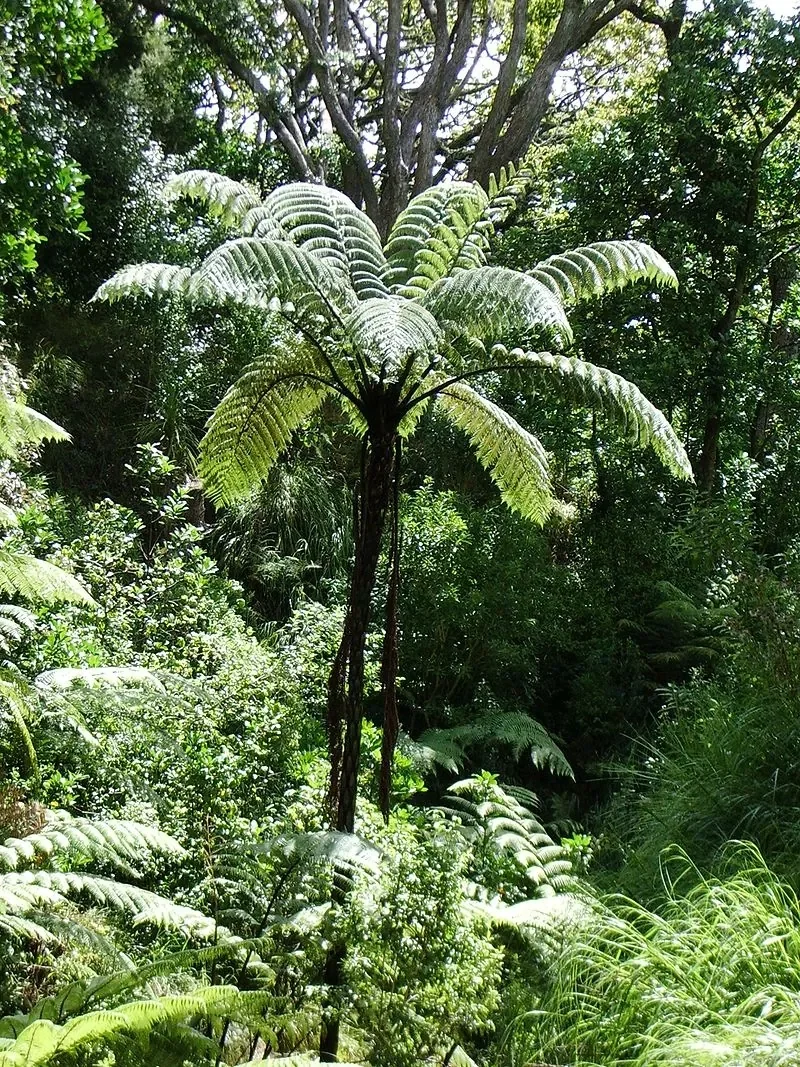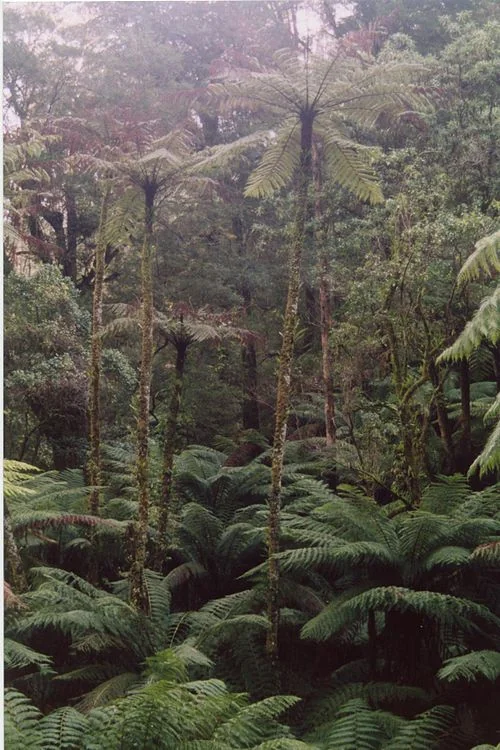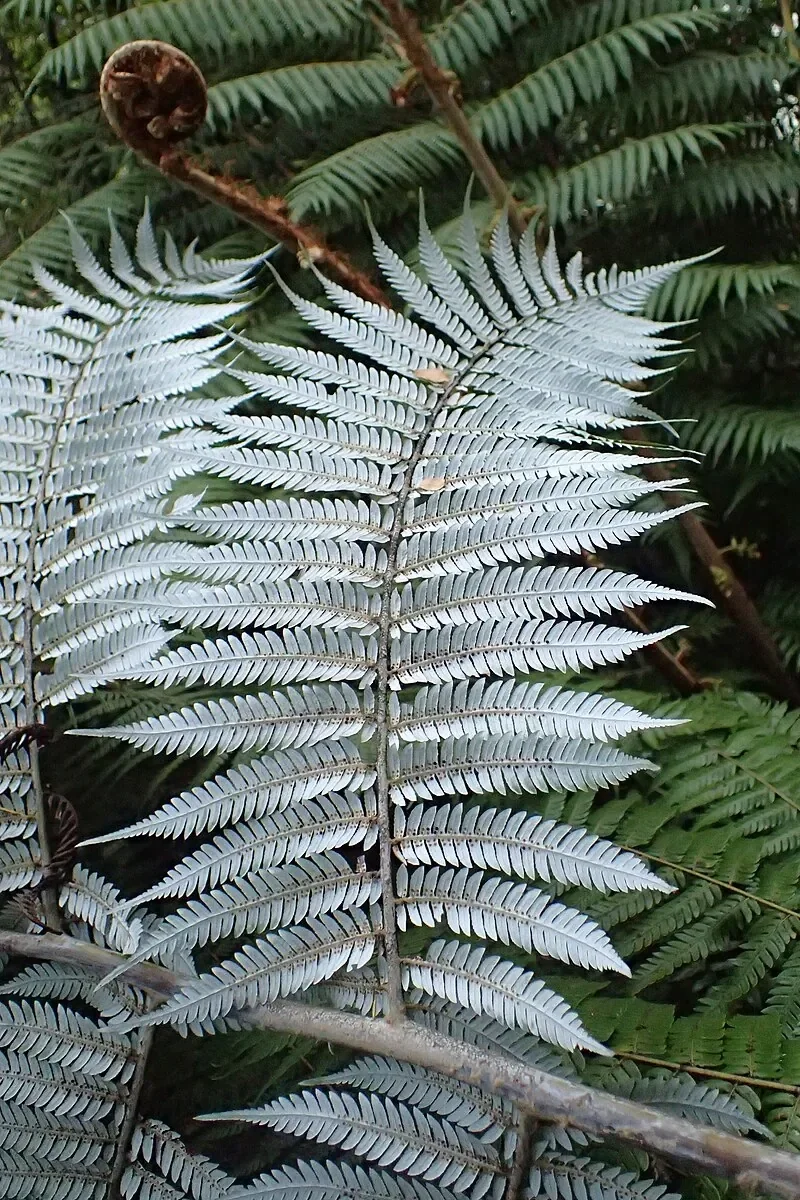
Black Tree Fern
Cyathea medullaris
Introduction
Introduction Overview
Cyathea medullaris , also known as mamaku or black tree fern, is a striking native New Zealand fern with a tall, black trunk and large, arching fronds. It is a prominent feature in lowland forests and valued for its dramatic appearance. native trees and ferns .

Plant Description
Botanical Features
Cyathea medullaris , commonly known as Mamaku or Black Tree Fern, is a large, evergreen fern native to New Zealand and distributed across the southwest Pacific. It is one of the tallest tree ferns in New Zealand, capable of reaching heights of up to 20 meters with a trunk diameter of up to 20 cm. The trunk is black and covered with distinctive hexagonal scars from shed frond bases. Its large, arching fronds can grow up to 6 meters long and are held on thick, black, rough stipes (frond stalks) covered in black scales with marginal spines. Dead fronds typically fall off, except in very young plants. It is a fast-growing species, thriving in lowland forests, including broadleaved, podocarp, beech, and kānuka forests, and can be abundant in disturbed sites undergoing regeneration. It prefers humus-rich, moist to wet soil in sheltered, lightly shaded positions, protected from strong winds and frost.
Quick Facts
Key Features
| Scientific Name | Cyathea Medullaris |
|---|---|
| Height | Up to 20 m (66 ft) |
| Spread | 2-4 m |
| Water Needs | High (requires consistent moisture) |
| Light | Part shade to full sun |
| Frost Tolerance | Low to moderate (protect young plants from frost) |
| Salt Tolerance | Low |
| Growth Rate | Fast |
| Lifespan | Many decades |
Climate Best Suited to
Thrives in warm, humid conditions typical of northern New Zealand. Prefers temperatures between 10°C and 25°C. Requires high humidity and protection from frost.
Regional Suitability
Common in lowland and coastal forests throughout New Zealand, especially in the North Island and northern South Island.
| City | Suitability |
|---|---|
| Whangārei | Ideal |
| Auckland | Ideal |
| Hamilton | Ideal |
| Tauranga | Ideal |
| Rotorua | Ideal |
| Gisborne | Ideal |
| New Plymouth | Ideal |
| Napier | Ideal |
| Whanganui | Ideal |
| Palmerston North | Ideal |
| Wellington | Ideal |
| Nelson | Ideal |
| Christchurch | Ideal |
| Dunedin | Ideal |
| Invercargill | Ideal |
Natural Habitat
Natural Habitat Overview
Cyathea is naturally found in specific habitats throughout New Zealand. Understanding its natural environment helps in providing appropriate growing conditions in cultivation.
Plant Conservation
Cyathea medullaris , also known as mamaku or black tree fern, is a common and widespread species found across the south-west Pacific, including New Zealand, Fiji, and Pitcairn Island. In New Zealand, it is considered one of the most common tree ferns and is found in various microclimates and situations, particularly in lowland forests throughout the North Island and in wetter coastal areas of the South Island.
While regional conservation status information may exist, general searches do not indicate that Cyathea medullaris holds a threatened or endangered status at a national or international level. Its prevalence in its native range suggests it is not currently a species of high conservation concern.
How to Grow
The Black Tree Fern (Cyathea medullaris) is a magnificent plant that thrives in conditions mimicking its natural lowland forest habitat. It requires consistently moist, humus-rich, and well-drained soil, along with sheltered, lightly shaded positions protected from strong winds and frost. Young plants are particularly sensitive to these environmental factors.
Soil
Moist, well-draining, rich in organic matter.
Light
Partial shade to full shade for best growth.
Water
Consistent moisture , especially when young.
Planting Guide
When to Plant
The best time to plant Cyathea is during spring or autumn when soil temperatures are moderate and rainfall is reliable.
How to Plant
Dig a hole twice the width of the root ball and slightly deeper. Place Cyathea in the hole, backfill with soil, and water thoroughly. Mulch around the base to retain moisture.
Ecological Role
Wildlife Interactions
Cyathea medullaris plays a significant ecological role in lowland forests. It provides crucial shade and shelter in the understory, creating microhabitats for a diverse range of invertebrates and mosses within its fronds. Furthermore, its sturdy trunk can host various epiphytes, contributing to the overall biodiversity and complexity of the forest ecosystem.
Uses and Significance
Garden Uses
- Striking feature plant for large gardens and parks
- Excellent for shaded, moist areas
- Provides shelter and habitat for native wildlife
Landscaping Uses
Landscaping Uses Overview
Cyathea is highly valued in landscaping for its aesthetic appeal and practical benefits. It can be used in various garden styles and landscape applications.
Seasonal Care Calendar
Spring
New fronds unfurl; keep soil moist and mulch around base.
Summer
Water during dry spells; protect from harsh sun.
Autumn
Remove old fronds; check for pests.
Winter
Minimal care needed; protect young plants from frost.
When to Prune and How Much
When to Prune and How Much Overview
Remove dead or damaged fronds as needed. Minimal pruning required.
Regular pruning of Cyathea helps maintain its health and desired shape. Remove any dead, diseased, or crossing branches to improve air circulation and reduce the risk of pest and disease problems.
For most native plants, light pruning throughout the growing season is better than heavy pruning at once. This approach encourages healthy new growth while maintaining the plant's natural form and character.
How to Grow Black Tree Fern
The Black Tree Fern, or Mamaku, is a majestic and fast-growing native tree fern, renowned for its tall, distinctive black trunk and large, arching fronds. It is a prominent feature in New Zealand's lowland forests and is highly valued for its dramatic appearance and cultural significance. While it is a robust plant, successful cultivation requires attention to its specific needs, particularly regarding moisture, shade, and protection from frost. It thrives in conditions that mimic its natural forest habitat, making it an excellent choice for shaded, moist gardens.
From Spores
Propagating Black Tree Fern from spores is a rewarding but challenging process that requires patience and specific conditions. Collect mature spores from the undersides of healthy fronds when they are dark brown and easily dislodge. Sow the spores onto a sterile, moist substrate, such as peat or a specialized fern-growing medium, in a sealed container to maintain high humidity. Keep the container in a warm, dimly lit location. Germination can take several weeks to months, forming a green, moss-like prothallus. Eventually, tiny fern sporophytes will emerge. Once they are large enough to handle, transplant them into individual pots and gradually acclimate them to lower humidity before planting out.
From Nursery-Grown Plants
For most gardeners, purchasing nursery-grown plants is the most practical and successful method for cultivating Black Tree Fern. Ensure you source plants from reputable native plant nurseries that specialize in ferns. When transplanting, minimize root disturbance and plant into a well-prepared site that meets all its environmental requirements: partial shade to full sun (with protection from harsh afternoon sun), consistently moist but well-drained, humus-rich soil, and protection from strong winds and severe frost. Regular watering, especially during dry periods, and occasional misting of the fronds will be essential for the plant's establishment and long-term health.
Pests and Diseases
Common Pests
Cyathea is generally resistant to most pests due to its native adaptations. However, it may occasionally be affected by common garden pests such as aphids or scale insects.
Disease Prevention
To prevent diseases, ensure good air circulation around Cyathea and avoid overwatering. Remove any diseased plant material promptly to prevent spread.
Cultural Significance
Cyathea medullaris , commonly known as mamaku or black tree fern, holds significant cultural importance, particularly within Māori culture in New Zealand. Its cultural significance spans traditional medicine, food, symbolism, and legends.
Traditional Medicine (Rongoā):
- Māori utilized mamaku as a traditional medicine (rongoā) to treat a variety of ailments. This included using it for skin conditions, boils, rashes, ulcers, bites, internal parasites, and sore throats.
- The pith from young fronds was applied as a poultice, and gum from the trunk was used for gastro-intestinal complaints.
- Young shoots were boiled to aid women in post-partum recovery. It was also effective for sunburn, eczema, blisters, and sore eyes.
Food Source:
- The pith and young fronds (koru) of the mamaku served as a food source, especially during periods of scarcity, earning it the name "famine food." The taste is often compared to turnips or marrow.
- While harvesting the pith typically killed the tree, it was considered highly nutritious and was eaten baked or as a relish at feasts. It was also believed to be beneficial for pregnant women and for recovery after childbirth.
Symbolism and Legends:
- The koru, the unfurling fern frond, is a significant symbol in New Zealand culture, representing new life, growth, and new beginnings. The mamaku's regenerative capacity in forest ecosystems, often being the first plant to colonize disturbed areas, reinforces this symbolism.
- In Māori tradition, the drooping fronds of the mamaku are associated with grief and sorrow. Māori pūrākau (legends) tell stories of the mamaku, including one where it is one of the children of Te Hapuku who transformed into a tree fern, and another where it was a lover turned into a tree fern by angry gods.
- The black tree fern is also referenced in the name of the New Zealand women's rugby team, the Black Ferns, further cementing its place in national identity.
Modern Applications:
- Beyond its traditional uses, mamaku extract is now incorporated into modern cosmetics for its soothing, moisturizing, anti-aging, hydrating, and collagen-boosting properties.
Bonus Tip
Expert Growing Advice
The Black Tree Fern ( Cyathea medullaris ), or Mamaku, is not only a majestic addition to any shaded garden but also holds a unique tactile warning. The distinctive black trunk, covered in hexagonal scars from shed frond bases, is often adorned with a fine, black, hair-like fur. While visually striking, this fur can cause skin irritation and itching upon contact. When handling or working near a Mamaku, especially during maintenance or planting, it's advisable to wear long sleeves and gloves to avoid discomfort. This small detail adds to the wild, untamed beauty of this iconic New Zealand fern.







